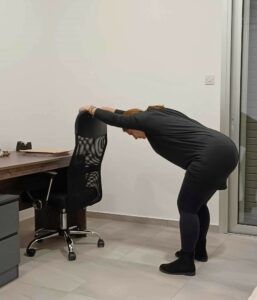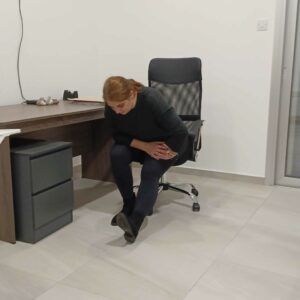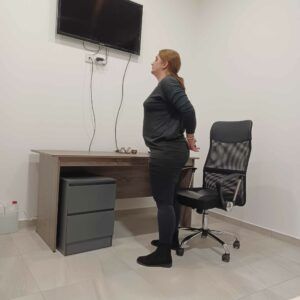If you are spending most of your time sitting behind a desk due to your job, then this article is for you. How often do you feel your neck and shoulders sored, and you have the need to just get up and do some stretching?
Well don’t worry, I got you covered. Even if you only have 1-5 minutes, you can try one or more of the following stretches to help you release muscle tension, whenever you feel you need it. You don’t even need to interrupt your work or wait on your break to do it. It is so easy you can just take a few seconds of your time to do maybe one stretch, continue work, and after a while try another stretch.
But have you ever noticed why a few hours at your desk can make your body feel stiff and your mind a bit sluggish? That’s because staying in one position for too long isn’t what our bodies were built for. By incorporating office stretches into your daily routine is not just good for your muscles, but it’s also great for your overall work performance. 
Stretching helps your body by increasing blood flow, which sends more oxygen to your brain and muscles. This can lead to better concentration and a sharper mental state. Plus, regular stretching has been shown to relieve the tension that builds up from prolonged sitting, which can absolutely enhance productivity and focus over the course of a workday.
Now, this isn’t just about feeling better. It’s about staying healthy. Office stretches are a form of proactive self-care that could help prevent a range of work-related injuries, such as carpal tunnel syndrome or lower back pain. When you stretch, you’re essentially reducing the risk of musculoskeletal disorders.
When you sit for long periods, certain muscles shorten and can become tight. Stretching helps to lengthen them back to their natural state, reducing this way the strain on your body.
So get ready because I’m here to help you carve out time in your busy schedule to get stretching and get productive.
Step-by-Step Guide to Office-Appropriate Stretches
I’m going to walk you through some stretches you can do right at your desk, no gym attire necessary. Let’s keep it simple and focus on stretches that hit the major areas that get tight during work: your neck, shoulders, back, and legs.
- Neck Stretch
For your neck, a gentle side stretch will do wonders. Tilt your head to the side, bringing your ear closer to your shoulder. Hold it there for about 20 seconds, then switch sides. You’re going to find out how much tension you’re holding in just a few seconds, trust me.

- Shoulder Stretch
Shoulders now, because they bear the brunt of poor posture. Roll them back and then draw circles with them, first forwards, then reverse. It’s not just about loosening up; it’s also about counteracting that hunched-over-the-keyboard posture.


- Back Stretch
Your back is crucial, so let’s give it some love. A seated spinal twist can realign things after hours of sitting. Cross one leg over the other and twist towards the crossed leg, using your arm on the back of your chair for an extra stretch.

Another stretch for the back is a back curve. Sitting or standing, put your hands together in front of you at shoulders’ height, and curve the back until you feel a stretch in your upper back. Hold for a few seconds.

One more stretch for the back, you can go behind your chair, and put your hands on top. Then take 1-2 steps backwards, bend your knees slightly, and lower your upper body forward, so that the arms, head, and back form one straight line. Hold for a few seconds.

- Leg Stretch
Don’t forget your legs. I’m here to help you prevent that dreaded leg numbness. Extend one leg out and flex your foot. Hinge forward at the hips, just slightly, until you feel a stretch at the back of your extended leg.

One more stretch for the legs is a seated hip stretch. In a seated position, cross one leg on top of the other like in the photo. Then lean slightly forward to feel the stretch in the hips. Hold for a few seconds.

- Chest Stretch
Stand up and put your hands together behind your back. Open the chest and shoulders back. Hold for a few seconds until you feel a stretch in your chest.

General tips: make sure you keep your movements smooth and controlled; jerking into a stretch is a no-no.
How often should you stretch? A good rule of thumb is every hour or so. Your body’s going to thank you for the mini-breaks. And if you’re worried about forgetting, set a timer or use an app to remind you.
Promoting a Stretch-Friendly Office Culture
The benefits extend beyond physical health. A stretch-friendly office can foster a more positive and collaborative environment. So how about trying to get your co-workers to stretch together? This way you can make sure you don’t skip your stretching if you know your co-worker is depending on you.
If you are an employer, consider the success stories from businesses that have embraced stretching at work. They report higher levels of employee satisfaction, lower stress levels, and an improved bottom line. Take cues from these examples and start small; even a few minutes dedicated to stretching each day can make a big difference.
Remember, promoting office stretches isn’t just about the here and now. It’s about establishing habits that contribute to long-term health and job satisfaction. So, choose something that resonates with you and your team. It’s a simple step with the power to transform your workplace for the better.
If you are also looking for a healthy way to promote weight loss with your co-workers or employees, check out my HealthyWage review.
If you liked this article, check out also my article on back exercises you can do at home. It will further help your back get stronger and pain free during work hours.
